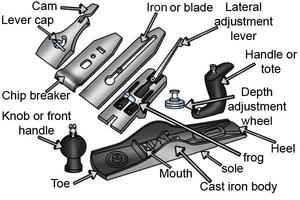I too think there's a lot to be said for buying vintage, and if you're willing to hunt car boots, local junk shops and maybe a recycling centre you might get one for next to nothing. Plenty of members have bought solid user planes for a fiver or so, and not a few have snagged ones for only one or two quid. I also like to plug Gumtree as a good hunting ground, I monitor this regularly and in general prices are good, with occasional stonking bargains sprinkled through the year.
If you are interested in buying an older plane you can widen your search parameters, there are quite a few brands beyond just Stanley and Record that are worth your consideration. The big two are just the most obvious names, but Marples planes for example are regarded by some as being the pinnacle of British production of Bailey-pattern planes and they tend to have a slight premium attached as a result, but only two weeks ago a no. 4 sold on eBay for £7.07 plus whatever the postage would have been.
For more names in addition to the Woden mentioned already by thetyreman on the previous page here's an old thread where I asked what are worth buying:
vintage-british-planes-worth-buying-t94472.html
Now vintage planes will generally need from a little to a fair bit of work to get into a fully usable state, it's rare (unicorn-horn rare) that you'll get one in original condition where it's 100% ready to go after a quick hone of the iron. So regardless of what you buy you should expect that it'll need work beyond the bare minimum of dusting, wiping down with white spirit, oiling/waxing, and doing whatever you like to refinish the handles.
I wouldn't let this put you off though as sorting it out will teach you some useful skills and will make the plane feel like your own. There's buckets of advice here and elsewhere on every aspect of plane fettling and refub/restoration should you need it, including fettling of the cap iron (a must-do if not already done by a previous owner, which is by all accounts very rare).
Even a basic cleaning will require the plane be taken completely apart and then put back together again so you'll learn what part goes where and how, knowledge every plane users absolutely needs. For the same reason even if you buy new it's worth taking the plane completely apart and then reassembling. And you might have to anyway as there is often excess oil or grease applied to protect from rust during transit.
So on to buying new. You don't have to pay a premium to get a good plane.
The idea that you have to pay a lot to get a good 'un is false. What paying more gives you of course is a better assurance that what you buy will be decent,
but that's not a guarantee. You can pay triple what some cheaper planes cost (i.e. approximately your full budget) and still get something that requires attention as a few complaint threads here have told us.
At the cheaper end but not at the very bottom a few members here have bought Faithfulls of various sizes and been very satisfied. I have a no. 4 and to say I'm happy with it is an understatement, it's a peach which I have set up as my super smoother and it required with very little work to get there. Even cheaper than this, see Paul Sellers on a few budget options:
Import Planes–Do/Can They Work? This is the first of a series of posts on these cheap planes, see further links underneath the text.
At this end of the market it's probably best to be realistic that there is a chance you'll get a Monday-morning/Friday-afternoon jobbie, so you might get a lemon and if so you should return it and get a replacement.
You may also be interested in this from Sellers back in 2013:
Reworking new planes to act like old and well used ones
































